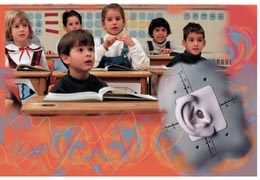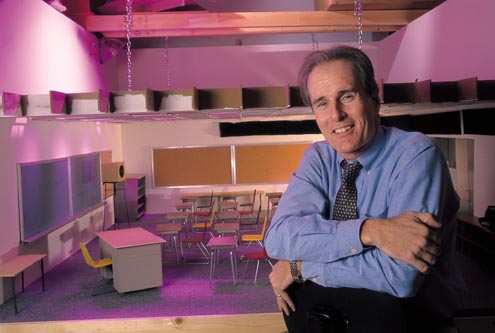 Listen
to the
Teacher
Listen
to the
Teacher
Good Classroom Acoustics Are Vital To Effective Learning
By Kristin Harmel
As the father of six children, Gary Siebein has listened to his share of classroom music recitals and spelling bees.
But as one of the world’s foremost experts on architectural acoustics, Siebein listens to things differently than other people. And the University of Florida architecture professor didn’t like what he wasn’t hearing in the classrooms.
"One of the first times I went into a classroom to observe what was going on, I noticed that the teacher had to turn the air conditioner off just to speak to the class, which is a good indication that, acoustically, something is very wrong," Siebein says. "It gives you a good idea just how poor the existing infrastructure is."
In a 1995 survey by the General Accounting Office, school administrators ranked poor acoustics as the most significant problem affecting the learning environment. Twenty-eight percent of responding schools, representing 11 million children, identified acoustics as being unsatisfactory or very unsatisfactory.
The impact of all this noise? Researchers at a 1997 conference of the Acoustical Society of America presented evidence that excessive noise levels impair a young child’s speech perception, reading and spelling ability, behavior, attention and overall academic performance.
So after years of helping to improve the acoustics of concert halls, theaters and even theme park attractions, Siebein decided to apply his expertise to identifying and curing acoustical problems in classrooms. What he and two UF colleagues found was students beyond the first or second row in a typical classroom hear only 50 percent of what their teacher says.
"Acoustics in the classroom is probably the number one overlooked problem in schools today," says communication sciences and disorders Professor Carl Crandell, one of Siebein’s partners in the study. "It’s really not rocket science. If kids can’t hear well, they won’t pay attention well, and they won’t learn."
The road to that conclusion began with a review of the existing literature. While there is a growing body of research on the extent of the problem and the impact on children, Siebein felt compelled to gather his own data on the causes.
"I’ve had enough experience with my kids’ classes to realize that a
lot of the research was oversimplified," he says. "From an architectural
point of view, some of the ways that things were measured seemed illogical,
and the measurements were all taken for situations that didn’t seem realistic
or even representative of true classroom behaviors." 
So Siebein, Crandell and interior design Professor Mary Jo Hasell decided to find out for themselves what students were, and were not, hearing, and why.
The trio began by simply observing how teachers taught at UF’s P.K. Yonge Laboratory School and several other schools in Alachua County, Fla. From there, they went on to test schools throughout the state.
"We wanted to organize in our minds the typical acoustic events of the day," Siebein says. "It became clear to us that most teachers didn’t just stand at the blackboard and teach. Many of them did what we called ‘walking the aisles,’ actively engaging students in the process. Teaching styles also differed greatly between grade levels. Before we did the technical work, we had to look at how students learn and how teachers teach. Acoustically, this set up a whole different situation for analysis."
Next, the research team mapped the classrooms and tried to plot the various acoustic scenarios that took place within them. Only then did they take measurements to quantify the situations they had observed. Armed with the data from the classrooms, Siebein returned to his studio to experiment. For him, that means modeling, a skill that was a hobby long before it became part of his vocation.
Siebein was five when his father, Walter, began to construct a model railroad in the family’s basement.
"I loved it," Siebein says. "My father built roads and houses to go with it — a whole little town — and I used to build houses, factories and furniture, even down to putting little pieces of paper on tiny desks."
While pursuing his architecture degree at Rensselaer Polytechnic Institute in Troy, N.Y., Siebein worked summers as a technical assistant at the American Shakespeare Theatre in Stratford, Conn., where actors had to make their words heard without the assistance of microphones.
"Seeing plays, operas, musical performances and concerts night after night, and hearing all the theories about acoustics that the performers and stagehands brought with them, developed my interest in acoustics," he says.
Drawn to acoustics, Siebein scrapped plans to open his own firm and decided to seek an advanced degree that would allow him to focus on his new passion. His search led him to the University of Florida, where Bertram Kinzey, one of the country’s foremost experts in acoustics, was running what was then the country’s only program dedicated to architectural acoustics. Siebein earned his master’s degree in architecture in 1980 and was immediately invited to join the UF faculty.
Today, he is one of the most respected teachers and practitioners of
architectural acoustics in the country. He pioneered measuring and modeling
techniques that are now standard practice in the field. 
"He’s in the class of some of the greatest contributors of all time to architectural acoustics and building acoustics," says Bill Cavanaugh, past president of the Institute of Noise Control Engineers, fellow in the Acoustical Society of America and editor of the National Council of Acoustical Consultants newsletter.
Like a musician, Siebein is enthralled with the way sounds ring through a room, the way they reverberate and resonate. But Siebein doesn’t make his music with a trumpet or a cello or a violin; his instruments are the walls, the floor and the ceiling. Like a virtuoso, he has learned to shape the tools of his trade to produce the clearest sounds.
"If you take a string off of a piano or a violin and pluck it, it doesn’t make music," he says. "The way those vibrations are enhanced by their instruments make the music. I think of rooms as instruments not just for one string, but for a whole orchestra."
 For the classroom
project, Siebein, his colleagues and graduate students used acoustic measuring
equipment to track reverberations, sound reflections and wall absorption,
first in actual classrooms, then in one-quarter-scale classroom models
they constructed.
For the classroom
project, Siebein, his colleagues and graduate students used acoustic measuring
equipment to track reverberations, sound reflections and wall absorption,
first in actual classrooms, then in one-quarter-scale classroom models
they constructed.
One of the biggest problems Siebein found was that air-conditioning noise was overpowering the teacher’s voice.
"Once noise levels in a room get above noise criteria of 25 or 30, which is equivalent to 30 or 35 decibels, most children are unable to understand what a teacher says from more than 12 feet away," Siebein says. "In our studies, we found very few classrooms that did not exceed this noise level."
The loudest air conditioners, generally window units, produced noise criteria ranging from 45 to 60, in some cases twice the level at which normal hearing is impacted, Siebein says. Only central air-conditioning units with acoustic treatment, with a noise criteria level of about 25 to 30, were deemed suitable for classroom use.
Armed with this new data, Siebein is leading an effort to include noise criteria in national guidelines for classroom construction or renovation. Last November, the U.S. Access Board accepted his findings as part of the basis for draft standards on school construction and renovation that could become part of the Americans with Disabilities Act (ADA). The board is the federal agency that updates and enforces the ADA. Depending on changes suggested during a year-long public comment period, the standards could become part of the ADA in May 2001. They would establish a maximum allowable background noise level of 35 decibels in the classroom, which Siebein says would make it much easier for children to concentrate. The code would require air-conditioning noise to be minimized and outside sounds — such as cars or airplanes — to be decreased with noise-reducing windows, doors and walls. Also, builders would be required to use sound-absorbing materials on floors, walls and ceilings.
"These types of improvements would help kids with learning disabilities and especially kids with attention deficit disorder," Crandell says. "A lot of studies have shown that kids don’t need Ritalin or other medications if they can hear well to begin with. Fixing the room through acoustic modification really is fixing the problem."
Siebein says the need to replace or retrofit air-conditioning units already has met with some resistance from educational leaders worried about increased costs. But Siebein’s own estimates are that the proposed changes would increase costs only from 2 to 10 percent, while the acoustically friendly building materials would increase costs by less than one half percent.
Having laid the groundwork for regulations that could have an enormous impact on the sound of education in the 21st century, Siebein is eager to promote similar steps in other learning environments, including gymnasiums, cafeterias, libraries and college lecture halls.
In the meantime, he is looking forward to watching the most meaningful project of his career shape the next generation of schoolchildren in America.
"Acoustical design in classrooms is growing more and more important as class sizes grow. We have kids who aren’t hearing a large amount of what their teachers are saying," Siebein says. "This is fundamental to improving the condition of education nationally. We’re taking the technology we’ve developed and hopefully using it to affect a huge number of people."
Gary Siebein
Professor, Department of Architecture
(352) 392-0205
siebein@nervm.nerdc.ufl.edu